M/Y CORAL I
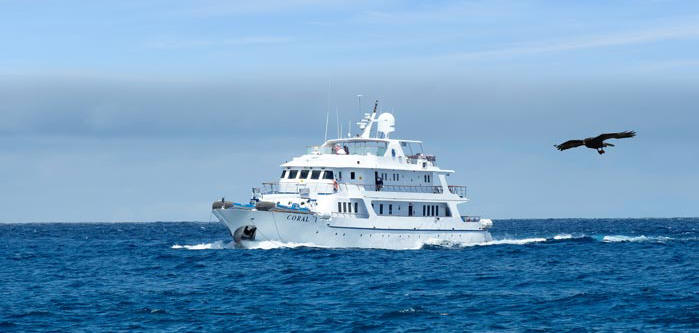
The M/Y Coral 1 cruises the Galapagos Islands with a European design and modern shape offers more space, comfort safe security for and a naturalist cruise. It is an attractive and functional mid-size (Mega yacht), perfect for an intimate experience when cruising the islands.
Some cabins are connecting, just
for families and special groups.
It has eighteen spacious cabins decorated with a marine taste.
There is plenty of room for storage, and moreover, all beds in all cabins are lower and they can be arranged as matrimonial, as well as single and double beds.
Each cabin has their own private facilities, hot
and cold shower with a fresh and lasting supply of water. All the cabins are provided with smoke detectors
and sprinkler system
The yachts provide comfortable lounges, dinning
parlours and conference areas with TV and VCR, a well stocked
bar, large picture windows, and best of all expansive
observation decks with sun/shade areas.
Your stay in Galapagos will be more lovely and pleasant in the relaxing, comfortable and intimate environment you will find on board our yachts.
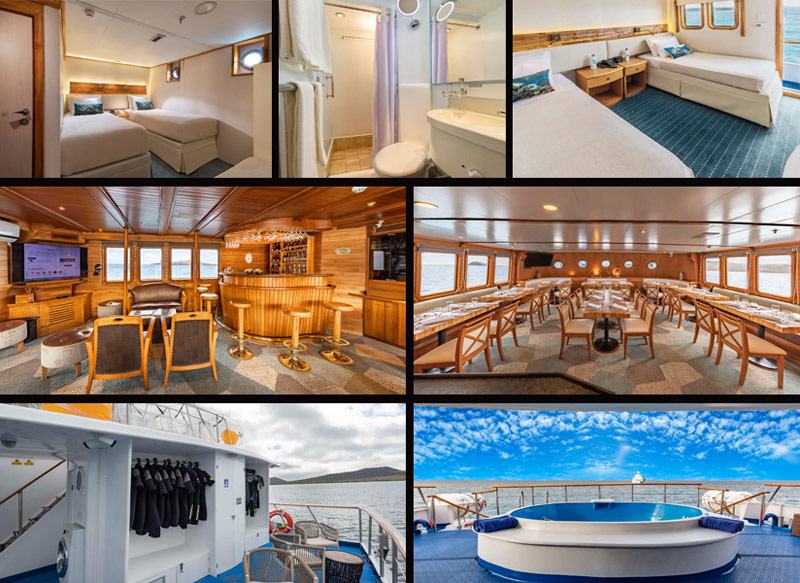
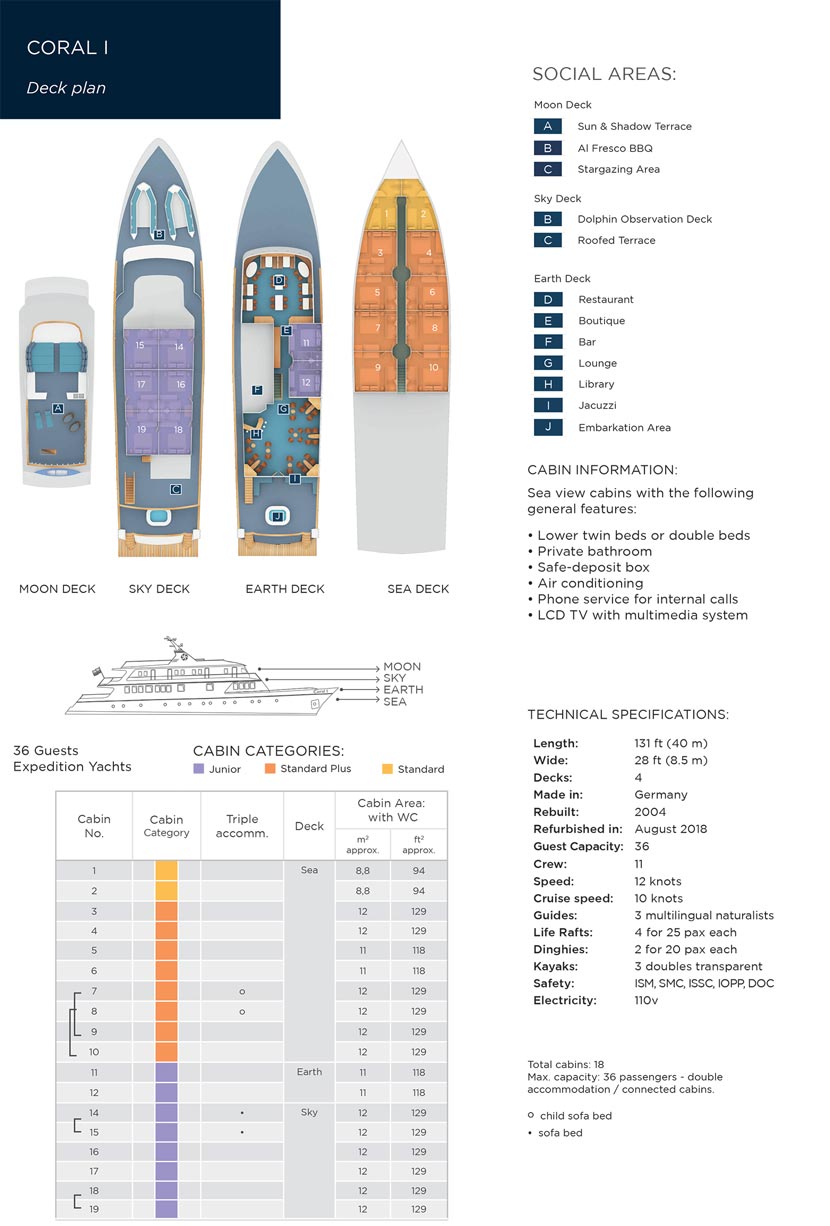
M/Y CORAL II
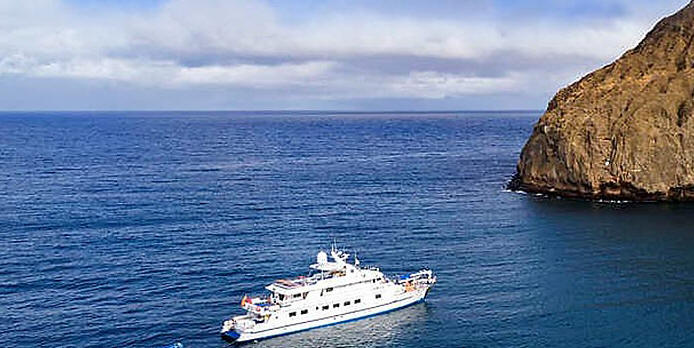
The M/Y Coral II is a landmark 11-cabin
yacht, styled in an era of eye-catching design, a beautiful
blend of form and function. She boasts romantic and cozy living
areas, intimate and modish dining, sleek and seductive outside
decks. Her amenities and outstanding service make her the ideal
yacht for experiencing the marvels of the islands.
The M/Y Coral II accommodates 20 passengers, ideal for those who
want to discover the islands with privacy, intimacy and supreme
comfort. Her excellent cruising speed means more time for
visiting the islands and enjoying activities, while her small
size means less time organizing shore visits.
All the cabins are equipped with: air conditioning, background
music, telephone, wall to wall carpeting, closets, safes,
private bathrooms that offer fresh hot & cold water, along with
a hair dryer and other amenities.
The Coral II provide comfortable lounges, dinning parlours and
conference areas with TV and VCR, a well stocked bar, large
picture windows, and best of all expansive observation decks
with sun/shade areas.
Your stay in Galapagos will be more lovely and pleasant in the
relaxing, comfortable and intimate environment you will find on
board our yachts.
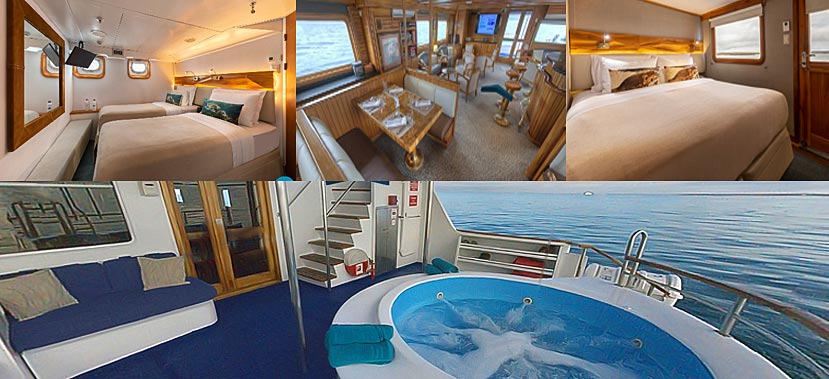
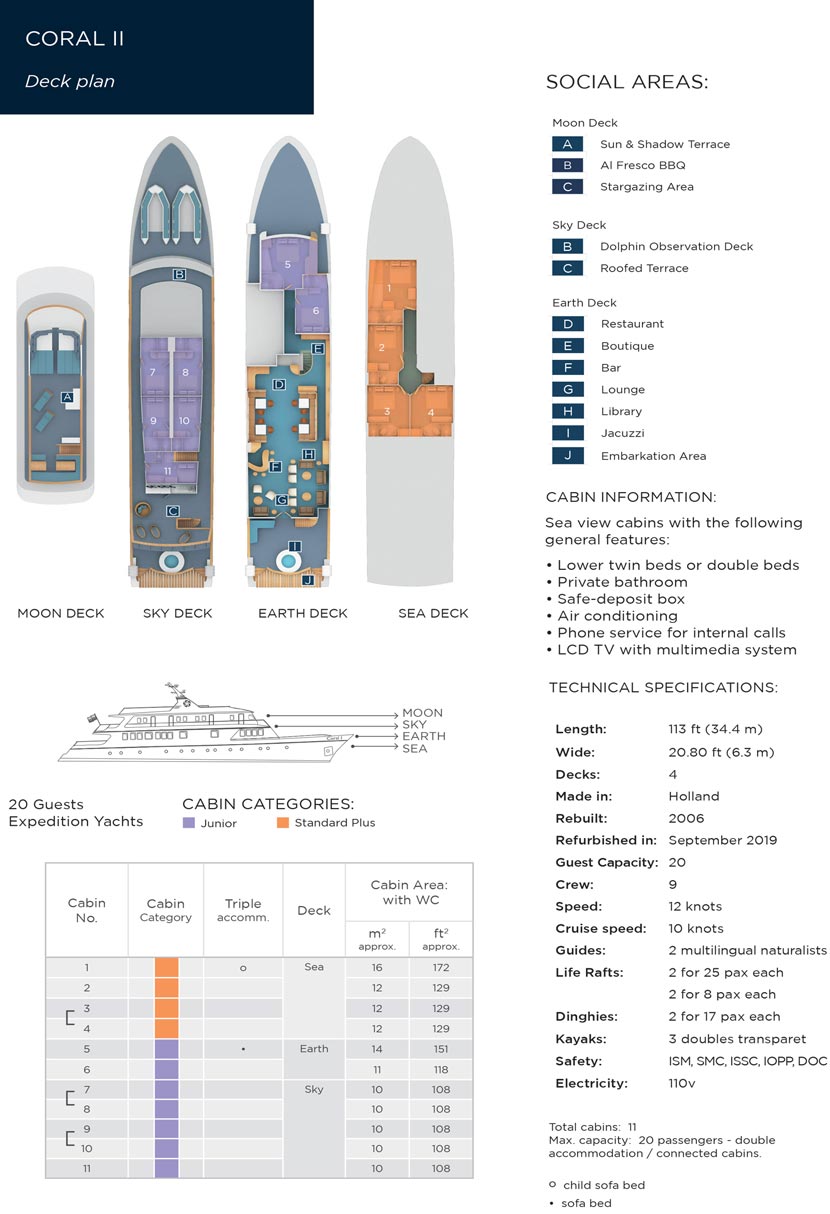
Galapagos Cruises Coral I (36) & Coral II (20 passengers)
Includes:
All meals, all shore excursiones, daily lectures, English speaking naturalist guides, cabins accommodations as per your choice.
Not included
• Air Ticket Quito or $ 450-600 per adult, $ 290-350 per
child under 12. Tickets are confirmed together with cruise . It
is mandatory that all passengers use the cruise line flights to
guarantee passenger dingy ride and luggage transfer from airport
to port and to ship, crew shifts, fresh cargo for cruise and
compliance with formalities before embarking to Galapagos. The
Cruise & Tara Tours Inc. is not responsible if passengers use
other flight schedules and miss the cruise or other services.
• Cruise -Galapagos fuel surcharge per person: $ 90 for 3 or 4
night cruise and $ 180 for the 7 nights.
• Entrance fee to Galapagos: $ 100 adult, $ 50 children under
12. Paid directly by the passenger
upon arrival in Galapagos (cash only) or invoiced and prepaid by
tour operator.
• INGALA Control Card $ 10 net per person
• Travel insurance, medical services and others not specified.
• Tips & personal expenses. Suggested per day per person $ 15
for crew / $ 10 for guide.
Optional on board plus VAT: (net per person in US$ subject to
change)
• Wet suits rental: 3 or 4 night cruises $ 25, 7 nights $ 50.
• Kayak rental: each use per person $ 30. Internet: 10 min $ 32.
• Alcoholic / non-alcoholic beverages.
M/Y Corals Itineraries Updated as Apr.06, 2022
CRUISE A (Sun-Wed) 4 day/3 nights
Day 1: Sunday - Baltra Airport
Departure from Quito or Guayaquil to Baltra Island (2,30 hours
flight). Arriving in Galapagos, passengers are picked up at the
airport by our natural guides and taken (ten minute bus drive)
to the pier to board the M/Y Coral I or M/Y Coral II.
PM - Fausto Llerena Breeding Center - Charles Darwin Station
(Santa Cruz Island)
Dry landing. Visit to the Galapagos giant tortoises breeding
program, where the famous Lonesome George (last surviving
specimen of Pinta Island) lived for decades.
The center is conducted by the Galapagos National Park (GNP)
staff with the collaboration of scientists from the Charles
Darwin Station (CDS). Here eggs taken from Pinzon, Santiago and
Santa Cruz Islands hatch with out the danger of introduced
species. After artificial incubation; the “galapaguitos”
(newborn tortoises) are reared until the age of 5, when they are
released in their native habitats, having the capabilities to
survive alone. Since the 70s, more than 2000 specimens have
returned to their own islands. In addition, the Darwin Station
works in several scientific projects, botanical research,
providing environmental education to communities, schools within
the Islands and tourists. If there is enough time, it is
possible to visit the town (Puerto Ayora).
Difficulty level: easy
Type of terrain: flat
Duration: 1,30 hours walk
Day 2: Monday - AM BARRANCO PM DARWIN BAY (GENOVESA)
AM – El Barranco, Prince Philip’s Steps (Genovesa Island)
Riding our pangas to the far side of the caldera, red-billed
tropicbirds display vociferously overhead while Galapagos fur
seals can be seen on the shoreline. Once at the top of the rocky
stairway we are immediately met by Nazca boobies, red-footed
boobies, mockingbirds and finches that line our way through a
palo santo forest until we arrive at an expansive open lava
field. Wedge-rumped storm petrels swarm above the lava where we
keep our eyes peeled for short-eared owls.
Difficulty level: Moderate
Type of terrain: rocky – lava
Duration: 45-minute walk
PM – Darwin Bay (Genovesa Island)
From within the flooded caldera of Tower Island we set foot onto
a sandy beach to be greeted by swallow-tailed gulls often said
to be the most beautiful gull in the world. Our short, flat,
trail leads us past stands of mangroves and saltbush on which we
have our best possible looks at nesting red-footed boobies and
great frigatebirds. At the tidal lagoon we may also see the
rarest gull in the world, our very own, endemic lava gull.
Difficulty level: Moderate
Type of terrain: Sand & Lava
Duration: 2 ½-hour walk aprox.
Day 3: Tuesday – Rabida Island
Wet landing. Dark-red sand covers the unique beaches of this
island, home of sea lions colonies; Rabida is considered the
epicenter of the Galapagos Islands due to the diversity of its
volcanic geology. Nesting brown pelicans are found from July
through September plus nine species of the famous Darwin’s
finches. Here a dinghy ride along marine cliffs is done, to
observe nesting seabirds. Snorkel off the coast, where marine
life is particularly active.
Difficulty level: easy
Type of terrain: sandy
Duration: 1,30 hours walk / 1 hour snorkeling / 1 hour
dinghy ride
PM – BARTOLOME ISLAND
Dry or wet landing. Discover a fascinating landscape resembling
the moon, formed by different volcanic parasitic cones, lava
bombs, spatter formations, cinder cones; hike to the summit for
impressive views of the closer islands, including the eroded
tuff cone Pinnacle Rock (perhaps the beast known postcard from
Galapagos). Here is possible to encounter lava lizards, and
blue-footed boobies. Beach time in Bartolome is a great
opportunity to snorkel and have a close look to penguins, sea
turtles and white-tipped reef sharks among a great variety of
colorful fish. Possibly the finest snorkeling experience; the
water here is generally clear, without too much waves.
Due to its geographical location, is immediately noticeable a
lack of vegetation, just pioneer plants are observed. They
include tiquilia nesiotica (silver look bush, which is endemic
to the island) and chamaesyce (known as sand mat or spurge).
Difficulty level: intermediate
Type of terrain: 372 steps trail
Duration: 1,30 hours walk / 1 hour snorkeling
Day 4: Wednesday - Black Turtle Cove (Santa Cruz
Islands)
On the north shore of Santa Cruz Island, accessible only by sea,
four species of mangrove crowd and form an internal lagoon,
turtles visit the calm waters, peaking their heads above the
surface while fish, rays circle below. White-tipped reef sharks
can be seen beneath the boat, plus sea birds, including
pelicans, herons and egrets.
This cove has been declared as a “turtle sanctuary”.
Difficulty level: easy Type of terrain: none Duration: 1 hour dinghy ride
Baltra Island airport
After the visit, passengers will be transferred to the airport
for return flight to
Guayaquil or Quito
Cruise B West (Wed-Sun) - 5 days / 4 nights
Day 1: Wednesday Santa Cruz
- AM – Baltra airport
Departure from Quito or Guayaquil to Baltra (2 ½ hours flight).
Passengers are picked
up at the airport by our naturalist guides and taken on a ten
minute bus drive to the
pier to board the Coral I or II
- PM – Highlands Santa Cruz-
Dry landing. A 45-minute bus ride will take us to the Santa Cruz
highlands, located to the northwest of Puerto Ayora, where we
will find a natural reserve with giant tortoises. These enormous
and slow-moving reptiles are responsible for the island’s name
and therefore approaching them in their humid and forested abode
is always an inspiring adventure. They can weigh between 250 and
300 kg and can live up to 150- 200 years.
Difficulty level: easy
Type of terrain: flat & muddy sometimes (depending on
season)
Duration: 45 minutes drive / 1h30 walk
Day 2:
Thursday Fernandina
Island
Dry landing. Espinosa Point is the only spot that we visit on
Fernandina, and from it we can see the island of Isabela across
the Bolívar Channel, an area that boasts some of the highest
diversity of endemic sea fauna in the Galapagos. The largest,
most primitive-looking race of marine iguanas* are found
mingling with sea lions and Sally Lightfoot Crabs; a wonderful
opportunity to encounter Flightless Cormorants at their nesting
sites, Galapagos Penguins and the “King” of predators on the
Islands, the Galapagos Hawk.
“Pa-hoe-hoe” and “AA” lava formations* cover the majority of the
terrain. Vegetation is thus scarce inland, but we encounter
Brachycereus cacti and extensive mangrove beds lining the
shores.
Difficulty level: intermediate
Type of terrain: rocky
Duration: 2 hours walk / 1hour snorkeling
- PM – Vicente Roca Point (Isabela)
Great deep-water* snorkeling at one of the richest marine havens
on Earth (Bolívar Channel). We take a dinghy ride along the
coast to observe a great diversity of sea and coastal birds*;
Nazca and blue-footed boobies, noddies, brown pelicans,
penguins, flightless cormorants. The upwelling of coldwater
currents in this part of the Galapagos gives rise to an
abundance of marine life.
Duration: 1 hour snorkeling / 1 hour dinghy ride
Day 3
: Friday Urbina Bay (Isabela)
- AM – Urbina Bay (Isabela)
Wet landing on a volcanic “black” beach. Depending on the
season, we may find giant tortoises*, land iguanas* and the
unusual Flightless Cormorant. After a short walk inland,
snorkeling time is allotted, giving you yet another chance to
swim with sea turtles, sea lions and countless tropical fish.
Urbina Bay features a wide variety of plant life that changes
depending on the season. We can observe the beautiful colors of
plants that attract different insects, birds and reptiles. We
will explore the uplifted coral reef that resulted from 1954
volcanic activity, with a spectacular view of Alcedo Volcano.
Difficulty level: intermediate
Type of terrain: flat
Duration: 1h30 walk / 1 hour snorkeling
- PM – Tagus Cove (Isabela)
Dry landing on Galapagos’ largest island where we will learn
about the eruption of the five volcanoes that form it. The trail
leads to Darwin’s salt-water crater Lake and excellent views of
lava fields and volcanic formations.
We will return by the same path for a dinghy ride along a
shoreline full of marine wildlife, where we will admire a
variety of seabirds*, such as Blue-footed Booby, Brown Noddy,
terns, Flightless Cormorant and depending on the season, a large
number of Galapagos Penguins* which are only 35 cm. tall; the
only penguin species in the world to extend its range into the
northern hemisphere along the equator. They are monogamous and
lay their eggs in small cracks of lava, on the lower parts of
the island near the shoreline not reached by the ocean waves.
The population of penguins on the islands is about 2,000
individuals, most of which live on this western portion of
Isabela; others are scattered further south on the island. We
will have an opportunity to snorkel in deep water. Graffiti
believed to have been left by19th-century pirates is a curious
reminder of an intriguing past.
Difficulty level: intermediate
Type of terrain: steep
Duration: 2 hour walk / 40 minutes dinghy ride / deep
water
snorkeling 1 hour
Day 4:
Saturday Santiago Island
- AM – Egas Port (Santiago Island)
Wet landing on a beach of black volcanic sand, visited by Darwin
in 1835. The rest section of the trail is comprised of volcanic
ash (eroded tu ) and the other half of partially uneven terrain
is comprised of volcanic basaltic rock lounging the shoreline.
The unique, truly striking layered terrain of Santiago’s shores
is home to a variety of resident and migrant birds, including
the bizarre Yellow-crowned Night Heron and astounding array of
marine wildlife including lobster, star sh and marine iguanas
grazing on algae beds alongside Sally Light-foot Crabs.
Colonies of endemic fur seals swimming in cool water pools
formed by volcanic rocks are also a highlight.
Difficulty level: intermediate
Type of terrain: the rst part at and then semi rocky.
Duration: 1h30 walk / 1 hour snorkeling
- PM – Sullivan Bay (Santiago Island)
Wet landing. This visitor site located at the southeastern
portion of Santiago Island, and of important geologic interest,
features extensive lava flows believed to have been formed
during the last quarter of the 19th century.
Difficulty level: dificult, 1.5 km path. Type of terrain: at
volcanic lava Duration: 1h30 walk / 1 hour snorkeling/swimming
Day 5:
Sunday Santa Cruz
- AM – Bachas Beach (Santa Cruz)
Wet landing on the north side of Santa Cruz; behind the beach
lie two small flamingo ponds with iguanas, coastal birds, Darwin
nches, mockingbirds, and gulls, as
well as interesting native and endemic vegetation, red and black
mangroves, salt bushes, and much more. This beach is one of the
main nesting sites of sea turtles* in the Galapagos. A female
can lay eggs 3 or 4 times with an average of 70 eggs each, but
then spend 3 or 5 years without breeding.
At this paradisiacal site we will also nd the remains of barges
that sank long ago, once property of the United States Navy when
they operated an airbase on Baltra Island during World War II.
That is why the beach is called “Bachas” because the word
“barges” in English was hard to pronounce for the local people.
Difficulty level: easy
Type of terrain: sandy
Duration: 1 hour walk / 1 hour snorkeling/swimming
- Baltra airport
Transfer to the airport for return flight to Guayaquil or Quito.
Cruise C (Sun-Wed) - 4 days / 3 nights
DAY 1 - SUNDAY ARRIVE GALAPAGOS -Darwin Station
am – Baltra Airport
Departure from Quito or Guayaquil to Baltra Island (2 ½-hour
flight). Arriving in the
Galapagos, passengers are picked up at the airport by our
natural guides and taken to a
ten-minute bus drive to the pier to board the M/Y Coral I or M/Y
Coral II.
PM – North Seymour Island
Dry landing. We visit the Station where the Galapagos giant
tortoise breeding program takes
place as part of our efforts to preserve the fragile Galapagos
environment and where the
famous Lonesome George (the last surviving specimen of his
species) lived for decades.
Admire a prickly-pear cactus forest and variety Darwin’s finches
and other land birds. The
Darwin Station also works providing environmental education to
the communities, schools,
and tourists visiting the Galapagos Islands. You will also have
some free time to visit the town
and shop for souvenirs.
Difficulty level: intermediate
Type of terrain: flat
Duration: 1 ½-hour visit
DAY 2 MONDAY
AM DARWIN STATION PM MOSQUERA ISLET
AM Charles Darwin Research Station & Fausto Llerena Breeding
Center (Santa Cruz Island)
Dry landing. This is perhaps one of the busiest tourist
destinations on the archipelago. Off of
Baltra Island (where the airport is located) and not far from
Santa Cruz, North Seymour is the most
accessible for day trips out of Santa Cruz’s main port, Puerto
Ayora.
An approximately two hour walk amidst large nesting colonies of
blue-footed boobies*,
magnificent and great frigatebirds,* and swallow-tailed gulls
for an in depth encounter with sea
bird breeding cycles and as well as sea lions. You will also
encounter sea lions, land iguanas, and
on a lucky day, you might even come across a Galapagos Snake.
Difficulty level: intermediate
Type of terrain: rocky ground
Duration: 2-hour walk / 30-minute snorkeling
PM MOSQUERA ISLET
Wet Landing, Mosquera Islet is located between North Seymour and
Baltra Island. This flat,
sandy island has a large colony of sea lions. It is also an
excellent site to observe shorebirds
such as herons and lava gulls. There is no trail on the islet,
the visitor can enjoy the open
area. Most of the islet is covered with sand and barren lava
rock. Very little sesuvium
portulacastrum plants grow on the sand.
Difficulty level: easy
Type of terrain: sandy
Duration: 1 ½-hour walk & snorkeling
DAY 3 TUESDAY SOUTH PLAZA & SANTA FE ISLAND
AM SOUTH PLAZA
Dry landing. There are two Plaza Islets (north and south)
located east of Santa Cruz Island.
On the northern part of the Islet, visitors begin the journey
along an impressive cactus
forest were colorful yellow and red land iguanas live, the
population number is around
300 animals; during the dry season they survive on fruits and
flowers of the opuntia cacti.
A peculiar thing to see in South Plaza is the hybrid iguana (sea
and land). When reaching
the highest point, tropicbirds can be seen. During the dry
season (June – January) the
usually greenish and yellowish vegetation change of color
creating a bright red landscape
(sesuviumedmonstonei plant).
Difficulty level: intermediate
Type of terrain: rocky
Duration: 2-hour walk
PM SANTA FE Island
Wet landing. Santa Fe shows white sand beaches surrounded by sea
lion colonies; through
the island path, an endemic cactus forest is passed, home the
Santa Fe land iguanas
(the largest in the islands). This island is the habitat for a
number of species, including the
Galapagos hawk, Galapagos snakes, rice rats (one of the few
endemic Galapagos rodents), a
variety of finches and one of the four mockingbird species of
the archipelago.
Difficulty level: intermediate
Type of terrain: rocky
Duration: 1 ½-hour walk / 1-hour deep-water snorkeling
DAY 4 WEDNESDAY AM LOBOS ISLAND PM SAN CRISTOBAL-DEPART
GALAPAGOS
AM LOBOS ISLAND
Wet
landing. Isla Lobos is approximately 20 minutes by boat from
Puerto Baquerizo Moreno. The
length of the trail is 850 meters, and the estimated travel time
is one hour. There is a small
population of blue-footed boobies and common frigatebirds nest
at this site.
You can see the two species of sea lions present in the
Archipelago. During the boat ride, you can
see brown pelicans several species of shorebirds.
Difficulty level: easy
Type of Terrain: water
Duration: 1:30 - hour walk
PM SAN CRISTOBAL AIRPORT
After the visit you will go to San Cristobal Airport for their
return flight to Guayaquil or Quito
Cruise D -South (Wednesday to Sunday) - 5 days / 4 nights
Day 1: Wednesday
- AM – San Cristobal airport
Departure from Quito or Guayaquil to San Cristobal (2 ½ hours
flight). Passengers are
picked up at the airport by our naturalist guides and taken on a
ten minute bus drive
to the pier to board the M/V Galapagos Legend.
- PM – Interpretation Center & Tijeretas Hill (San Cristóbal)
Dry landing in Puerto Baquerizo Moreno, capital of the Galapagos
Islands. Passengers
visit the Interpretation Center, an excellent place to learn
about Natural History
in the Galapagos*. The Museum of Natural History displays
information on the
volcanic origins of the islands, their remoteness from the
continent, ocean currents,
climate, the arrival of the different species and their
colonization, among other points
of interest. The human history is also showcased,
chronologically narrating the most
significant events related to the discovery and colonization of
the islands.
Difficulty level: easy
Duration: 1 hour visit
Tijeretas Hill involves a high intensity walk amidst beautiful
landscapes and a
magnificent view at the foot of a frigatebird nesting colony*.
Difficulty level: high
Duration: 1 hour visit
Day 2: Thursday
AM Cerro Brujo (San Cristobal)
Wet landing. Cerro Brujo is an eroding tuff cone that at several
locations is composed of
AA lava formations and a beautiful white sandy beach, great for
snorkeling and sunbathing.
There is a lagoon visit where migratory bird species can be
seen: Black-necked Stilts, Ruddy
Turnstones, Whimbrels, other sandpiper species and White-cheeked
Pintails. Cerro Brujo
offers beautiful views of Kicker Rock, the southern part of San
Cristobal and the
vadjacent coast.
Difficulty level: easy
Type of terrain: sandy
Duration: 1-hour walk / 1-hour snorkeling
PM Pitt Point (San Cristobal)
Wet landing followed by a high-intensity hike on rocky terrain.
The trail includes a 90 meters
long, olivine beach and a path that climbs to the top of a
volcanic tuff, through several
magnificent viewpoints. This is probably the only site where the
three booby species of
the Galapagos can be seen together, as well as, two species of
frigate birds and a sea lion
colony. It is also excellent for dinghy rides and snorkeling,
where a good range of sea birds
can be observed.
Difficulty level: difficult
Type of terrain: rocky
Duration: 2½-hour walk/ 40-minutes snorkeling or kayaking
Day 3: Friday
AM Suarez Point (Espanhola)
Dry landing. An island of geological interest, we explore
volcanic formations and a
riveting wildlife: large sea lion colonies and seabirds
including Española mockingbird,
Nazca Boobies and the spectacular Red-billed Tropicbird. You
will also encounter
marine iguanas, lava lizards, and the colorful Sally Lightfoot
Crabs.
A somewhat lengthy hike will bring you among Nazca and
Blue-footed Boobies*,
right up to nesting grounds that sometimes overlap the trail.
Other birding favorites
include Galapagos Dove, Galapagos Hawk, Swallow-tailed Gulls and
the world’s
largest colony of Waved Albatross*, an unequivocal highlight
during mating season
(May-December).
Admire the island’s dramatic backdrop, featuring the famous
Soplador, a seaward
blowhole that shoots water some 23 m. (75 ft.) in the air.
Difficulty level: difficult
Type of terrain: rocky
Duration: 2h30 walk
PM Gardner Bay (Espanhola)
Wet landing on a beautiful white coral sandy beach guarded by a
colony of sea lions. There
are no trails, so we stay along the shore where we can spot
Galapagos hawks, American
Oystercatchers, Galapagos Ground Doves, Hood mockingbirds,
Yellow Warblers, lava lizards,
marine iguanas, and three species of Darwin’s finches: a
subspecies of the Large Cactus
Finch, which is similar to the large ground finch, the Small
Ground Finch (Geospiza fuliginosa)
and the Warbler Finch (Certhidea Olivacea), another endemic
subspecies. Swimming and
snorkeling offer a great variety of the Galapagos’ marine
wildlife: king angelfish, Creole fish,
damsel fish, parrotfish, manta rays, and white-tipped reef
sharks.
Difficulty level: easy
Type of terrain: sandy
Duration: 1-hour walk / 1-hour snorkeling
Day 4: SATURDAY AM Cormorant Point PM Post
Office (Floreana)
- AM – Cormorant Point /
Devil’s Crown / Champion (Floreana)
Wet landing, on an olivine green sand beach. We hike from the
black mangrove beds
to a brackish lagoon, which usually holds one of the largest
flamingo populations in the
Galapagos. This island features some endemic plants such as
Scalesia villosa, white and
black mangrove, and holy stick. The trail continues to a
beautiful white-sand beach, one
of the most important nesting sites of Green Pacific Sea
Turtles. It is important to
avoid walking in the water due to the Sting Rays that may be
hiding in the sand, which
can be dangerous if accidentally stepped on. From the beach one
can spot sea turtles,
Blue-footed Boobies plunging into the water, and small reef
sharks floating along the
shoreline in search of food.
This coral-sand beach marks the end of our trail, and we head
back to the olivine
beach we landed on to swim or snorkel amongst sea turtles, reef
fish, sea lions and, on
a good day, white-tipped reef sharks. A small colony of penguins
resides on Floreana
and can sometimes be observed as well.
Difficulty level: easy
Type of terrain: sandy and walk on a flat terrain
Duration: 1 hour walk / 1 hour snorkeling
- PM Post Office (Floreana)
Wet landing. Located on the north side of Floreana, the bay is
so-named because in
1793 Captain James Colnett installed a wooden barrel which
served as an informal
post office for sailors passing through, who would take letters
with them to their
destinations. Today, our visitors continue the tradition by
placing unstamped postcards
inside the barrel that should reach their destinations for free.
It can take weeks,
months, even years, not arrive at all, or even arrive before
you!
We may also encounter Darwin’s finches*, Yellow Warbler and lava
lizards. Great
snorkeling opportunities with Green Pacific Sea Turtles* as
well, this island is best
known for its endemic vegetation: Scalesia villosa, Lecocarpus
pinnatifidus, and Galapagos
milkwort. Snorkelers can practice on the main beach among
playful sea lions.
Difficulty level: easy
Type of terrain: sandy
Duration: 30 minutes walk / 1 hour snorkeling
Day 5: SUNDAY AM HIGHLANDS SANTA CRUZ PM
DEPART
- AM – Highlands Santa Cruz
Dry landing. In the mountains of Galapagos is possible to admire
different kind of birds, such as: tree and ground finches,
vermillion flycatchers, paint-billed crakes, yellow warblers,
and cattle egrets (usually standing on the tortoises’ shell).
The journey to the reserve offers great opportunities to see the
contrasts that the island offers in reference to the variety of
ecosystems. The road goes from the coast through the
agricultural zone and straight up to the dense humid forests.
Often, Galapagos Giant Tortoises are also seen on the way,
wandering through pastures in the paddocks. This spot is a
birdwatchers’ haven, since almost every land bird present on the
island lives or migrates here. Difficulty level: easy Type of
terrain: flat & muddy (depending on season) Duration: 45-minute
drive / 1 ½-hour walk
Then transfer to Baltra airport for flight to Quito or Guayaquil
7 night
cruises (Sun to Sun or Wed to Wed)
It is a combination of itineraries A + B or C+D cruises (also
B+C or D+A)
SN: Snorkeling KY: Kayak DR: Dinghy ride
For questions or further information about these programs
Have your Travel Agent call Tara Tours at 1-800-327-0080 or
e-mail us tara@taratours.com
